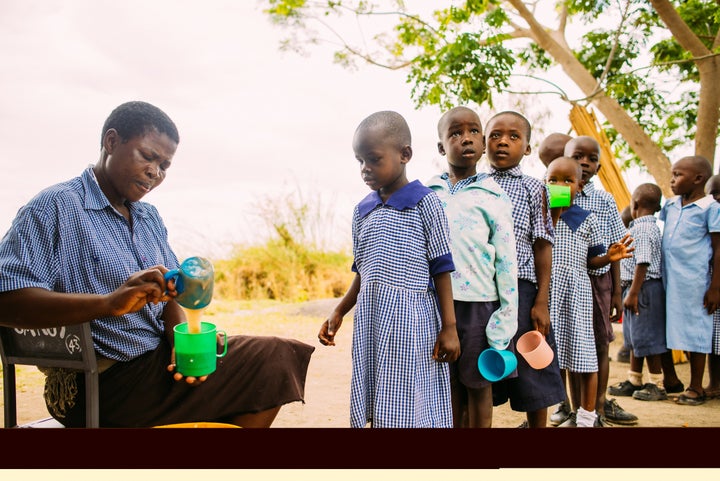
High levels of infant mortality due to malnutrition and pollution are closely linked, as new research by the World Health Organization (WHO) and The Economist Intelligence Unit shows. Those countries with unsustainable agricultural practices also tend to register high levels of malnutrition. But sustainable agriculture and simple environmental interventions can tackle these twin causes head-on, as current examples of high-yield, low-impact agriculture demonstrate.
Tropical diseases, armed conflict, and natural disasters often grab the headlines. But over a quarter of all annual deaths of children aged under five years old are due to a less dramatic, easily-preventable cause: unhealthy environments. Two new reports by the World Health Organization (WHO) reveal that 1.7 million children under five die every year because of environmental risks such as air pollution, second-hand smoke and lack of sanitation.
This is because these risks, in turn, cause diarrhea, malaria and pneumonia ― among the biggest killers of children aged one month to five years, according to the WHO’s Inheriting a Sustainable World: Atlas on Children’s Health and the Environment. Polluted environments are “deadly” for young children, says WHO Director-General Margaret Chan. “Their developing organs and immune systems, and smaller bodies and airways, make them especially vulnerable to dirty air and water,” she explains.
The companion report, Don’t pollute my future! The impact of the environment on children’s health, reveals that 570,000 children under 5 years die annually from respiratory infections, such as pneumonia, caused by air pollution and second-hand smoke. A further 361,000 children die because of diarrhea—the result of poor sanitation and lack of clean water—while another 270,000 die during their first four weeks due to poor sanitation, lack of access to clean water and air pollution. Simple environmental actions, such as removing mosquito breeding sites and covering drinking wells, could prevent another 200,000 child deaths from malaria.
Capturing the links between food sustainability and health
Pollution is closely tied up with other challenges for developing countries, particularly the field of food sustainability. Poor agricultural practices ― involving the heavy, unregulated use of fertilizers and pesticides, the overuse of water supplies, lack of diversification and high agro-industrial emissions ― not only impair the sustainability of agriculture but contribute significantly to the environmental risks and associated deaths outlined above. The Food Sustainability Index (FSI), developed by The Economist Intelligence Unit with the Barilla Center for Food and Nutrition, captures many of these linkages between food sustainability, environmental risks and child mortality.
The FSI provides a score and ranking for 25 major countries based upon the pillars of sustainable agriculture, food loss, and waste and nutritional challenges. Those countries that are scored poorly in the sustainable agriculture pillar (which contains sub-indicators relating to pesticide use, water use and emissions) tend to also perform badly in the nutritional challenges pillar—and also show high rates of child mortality. India, for example, scores just 40.51 (out of 100) for the sustainability of its agriculture and 45.04 for its progress in addressing nutritional challenges, coming last in both categories and overall. Germany, by contrast, scores 65.50 for sustainable agriculture and 63.06 for nutritional challenges, coming fourth overall. According to World Bank data, India’s child mortality rate was 48 per 1,000 live births in 2015, compared with just four in Germany.
Of course, there are a huge range of differences between the high-income economies and developing-world countries evaluated by the FSI. Varying agricultural practices, industrial policies and demographic demands all play a role in how these countries articulate their approaches towards food and health. But the FSI’s heat map shows that unsustainable agriculture and severe nutritional challenges tend to cluster in the same, low-income countries. Within these pillars, there is a lot of overlap between the countries scoring the worst for sustainable agriculture categories such as water management (Egypt, India and Indonesia) and environmental impact of agriculture on the atmosphere (China, India and Indonesia) on the one hand, and those scoring worst for nutritional challenges such as under-five nutrition and body weight (Indonesia, Ethiopia and India), on the other hand.
Success stories already exist
As a result, a broad, multi-area effort to improve food sustainability in these countries could make massive inroads against malnutrition and child mortality. Data presented by the FSI shows that nutrition-related factors contribute to 45% of deaths in children under five worldwide. As outlined by the WHO above, 25% of child deaths are caused by pollution, many of them specifically due to pollution linked to agricultural practices. If countries can implement agricultural practices which dramatically expand the yield and variety of foodstuffs available to their populations, as well as minimizing pollution and adverse effects on the environment, well over one-half of all child mortality could be eliminated. Burdens on developing-world health systems and economies caused by high rates of illness and mortality would also be hugely reduced.
Such a recipe—high-output, low-impact agriculture—might sound impossible. However, as the FSI shows, some countries are already moving towards that balance. And encouraging smaller-scale examples abound. Take Tanzania’s Kihamba agroforestry system: 120,000 hectares of sustainable farming across Mount Kilimanjaro’s southern slopes, including bananas, vegetables, coffee and trout aquaculture, provide livelihoods for an estimated one million people. Or there’s the recent renaissance of traditional, ecologically-minded farming in China. In Wanzai, Jiangxi Province, a program of organic agriculture, including rice, ginger, soybean, strawberries and other cash crops, involves 17,000 households and provides Wanzai County’s main development strategy. Urban farming initiatives—pioneered by countries such as Israel and Indonesia—also have an important part to play.
The know-how and expertise already exist. If policymakers and communities can think laterally across agriculture, health, and sustainability, we can strike a major blow against child mortality and safeguard the environment at the same time.
